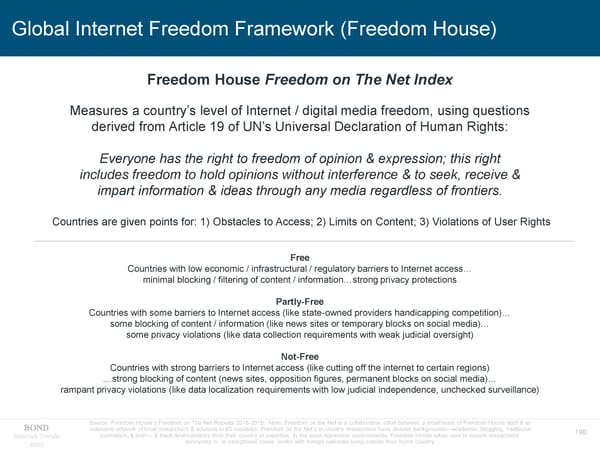Global Internet Freedom Framework (Freedom House) Freedom House Freedom on The Net Index Measures a country’s level of Internet / digital media freedom, using questions derived from Article 19 of UN’s Universal Declaration of Human Rights: Everyone has the right to freedom of opinion & expression; this right includes freedom to hold opinions without interference & to seek, receive & impart information & ideas through any media regardless of frontiers. Countries are given points for: 1) Obstacles to Access; 2) Limits on Content; 3) Violations of User Rights Free Countries with low economic / infrastructural / regulatory barriers to Internet access… minimal blocking / filtering of content / information…strong privacy protections Partly-Free Countries with some barriers to Internet access (like state-owned providers handicapping competition)… some blocking of content / information (like news sites or temporary blocks on social media)… some privacy violations (like data collection requirements with weak judicial oversight) Not-Free Countries with strong barriers to Internet access (like cutting off the internet to certain regions) …strong blocking of content (news sites, opposition figures, permanent blocks on social media)… rampant privacy violations (like data localization requirements with low judicial independence, unchecked surveillance) Source: Freedom House’s Freedom on The Net Reports 2016-2018. Note: Freedom on the Net is a collaborative effort between a small team of Freedom House staff & an extensive network of local researchers & advisors in 65 countries. Freedom on the Net’s in-country researchers have diverse backgrounds—academia, blogging, traditional Internet Trends journalism, & tech— & track developments from their country of expertise. In the most repressive environments, Freedom House takes care to ensure researchers’ 190 2019 anonymity or, in exceptional cases, works with foreign nationals living outside their home country.
 Internet Trends 2019 - Mary Meeker Page 36 Page 38
Internet Trends 2019 - Mary Meeker Page 36 Page 38